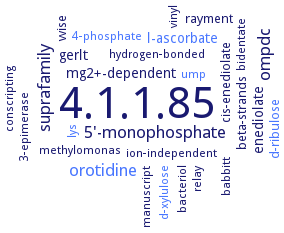4.1.1.85: 3-dehydro-L-gulonate-6-phosphate decarboxylase
This is an abbreviated version!
For detailed information about 3-dehydro-L-gulonate-6-phosphate decarboxylase, go to the full flat file.

Word Map on EC 4.1.1.85 
-
4.1.1.85
-
ompdc
-
orotidine
-
5'-monophosphate
-
suprafamily
-
mg2+-dependent
-
enediolate
-
l-ascorbate
-
gerlt
-
wise
-
beta-strands
-
cis-enediolate
-
rayment
-
d-ribulose
-
ump
-
bidentate
-
d-xylulose
-
babbitt
-
ion-independent
-
vinyl
-
3-epimerase
-
conscripting
-
methylomonas
-
hydrogen-bonded
-
lys
-
4-phosphate
-
manuscript
-
relay
-
bacteriol
- 4.1.1.85
- ompdc
- orotidine
-
5'-monophosphate
-
suprafamily
-
mg2+-dependent
-
enediolate
- l-ascorbate
-
gerlt
-
wise
-
beta-strands
-
cis-enediolate
-
rayment
- d-ribulose
- ump
-
bidentate
- d-xylulose
-
babbitt
-
ion-independent
-
vinyl
-
3-epimerase
-
conscripting
-
methylomonas
-
hydrogen-bonded
- lys
- 4-phosphate
-
manuscript
-
relay
-
bacteriol
Reaction
Synonyms
3-keto-L-gulonate 6-phosphate decarboxylase, KGPDC, More, SgaH, SgbH, UlaD
ECTree
Advanced search results
Crystallization
Crystallization on EC 4.1.1.85 - 3-dehydro-L-gulonate-6-phosphate decarboxylase
Please wait a moment until all data is loaded. This message will disappear when all data is loaded.
purified recombinant enzyme complexed with L-gulonate 6-phosphate, L-threonohydroxamate 4-phosphate, and L-xylitol 5-phosphate, analogues of the substrate, enediolate intermediate, and product, as well as with the product L-xylulose 5-phosphate, 15 mg/ml protein in 50 mM HEPES, pH 7.5, 5 mM MgCl2, 100 mM NaCl, micro-batch method, 0.01 ml protein solution mixed with equal volume of crystallization solution containing 16% monomethyl PEG 5000, 100 mM Bis-Tris propane, pH 7.0, and 5 mM MgCl2, with 25 mM ligand, X-ray diffraction structure determination and analysis at 1.2, 1.8, 1.7, and 1.8 A resolution, respectively
purified recombinant mutant enzymes K64A, H136A, E112Q, and E112Q/H136A, in complex with reaction intermediate analogue L-threonohydroxamate 4-phosphate, 15 mg/ml protein in 50 mM HEPES, pH 7.5, 5 mM MgCl2, 100 mM NaCl, 0.01 ml protein solution mixed with equal volume of crystallization solution containing 16% monomethyl PEG 5000, 100 mM Bis-Tris propane, pH 7.0, 5 mM MgCl2, and 25 mM L-threonohydroxamate 4-phosphate, X-ray diffraction structure determination and analysis at 1.7, 1.9, 1.8, and 1.9 A resolution, respectively
purified recombinant wild-type and selenomethionine-labeled enzymes, free or complexed with inhibitor L-gulonate 6-phosphate, 15 mg/ml protein in 50 mM HEPES, pH 7.5, 5 mM MgCl2, 100 mM NaCl, room temperature, micro-batch method, 0.01 ml protein solution mixed with equal volume of crystallization solution containing 18% monomethyl PEG 5000, 50 mM NaH2PO4, 50 mM K2HPO4, and 50 mM Bis-Tris propane, pH 7.0, with or without 20 mM inhibitor L-gulonate 6-phosphate, crystals appear a few days after microseeding, growing for 1 week, X-ray diffraction structure determination and analysis at 2.0 A resolution
purified recombinant wild-type and mutant enzymes E112D/R139V, E112D/T169A, and E112D/R139V/T169A, 15 mg/ml protein in 50 mM HEPES, pH 7.5, 5 mM MgCl2, 100 mM NaCl, micro-batch method, 0.01 ml protein solution mixed with equal volume of crystallization solution containing 16% monomethyl PEG 5000, 100 mM Bis-Tris propane, pH 7.0, 5 mM MgCl2, and 25 mM L-xylulose 5-phosphate or D-ribulose 5-phosphate, cryoprotection of crystals in 15% monomethylPEG 5000, 100 mM PIPES, pH 7.0, 15% ethylene glycol, 200 mM NaCl, and 50 mM L-threonohydroxamate 4-phosphate or 50 mM D-ribulose 5-phosphate, X-ray diffraction structure determination and analysis at 1.6-1.8 A resolution, molecular replacement
at 289 K using the hanging-drop vapor-diffusion technique. Apoenzyme obtained in two different space groups P212121 (without Mg2+) and I422 (in complex with Mg2+) and in the absence and presence of the product analog D-ribulose 5-phosphate. An 8 A alphaB-helix movement and other structural rearrangements around the active site between the apostructures and product analog bound structure. Conformational flexibility around the active site for substrate/product binding. Especially the alphaB-helix (residues 144-149) and the side chains of the conserved Arg144 and Arg197 exhibit openclosed conformational changes between the apo-structure and complex structure with ligand bound at the active site
-


 results (
results ( results (
results ( top
top





